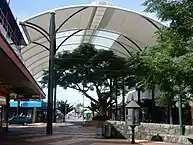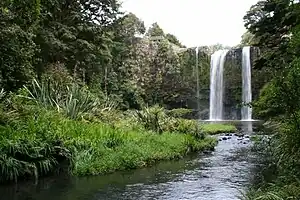Whangārei
Whangārei (Māori: [faŋaːˈɾɛi]) is the northernmost city in New Zealand and the regional capital of Northland Region. It is part of the Whangārei District, a local body created in 1989 from the former Whangārei City, Whangārei County and Hikurangi Town councils, to administer both the city proper and its hinterland. The city population was estimated to be 56,900 in June 2023,[2] an increase from 47,000 in 2001.
Whangārei
Whangārei-Terenga-Parāoa (Māori) | |
|---|---|
From top, left to right: Whangārei city from Mt Parihaka, Whangārei Marina, Whangārei Falls, Whangārei Mall, the entrance of the Hundertwasser Art Centre | |
| Nickname(s): The Rei, Whangas | |
| Motto(s): Non Nobis Solum, Love It Here, City of 100 Beaches | |
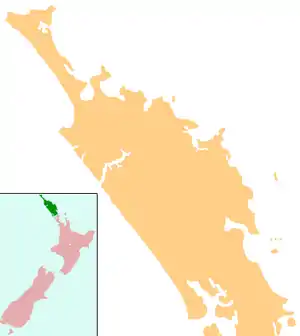 Whangārei  Whangārei | |
| Coordinates: 35°43′30″S 174°19′25″E | |
| Country | New Zealand |
| Region | Northland |
| Territorial Authority | Whangarei District |
| Pre 1989 | Whangārei County and Whangārei City |
| Named for | Reipae, a Waikato Princess[1] |
| NZ Parliament | Te Tai Tokerau (Māori) Whangārei |
| Government | |
| • Mayor | Vince Cocurullo |
| • MPs | Kelvin Davis (Labour) Emily Henderson (Labour) |
| Population (June 2023)[2] | |
| • Urban | 56,900 |
| Time zone | UTC+12 (NZST) |
| • Summer (DST) | UTC+13 (NZDT) |
| Postcode | 0110, 0112 (urban) |
| Area code | 09 |
| Website | www |
Etymology
The origin of the name Whangārei is unclear, as a number of pūrākau (Māori traditional stories) are associated with the harbour. One major tradition involves the sisters Reitū and Reipae of the Tainui migratory waka, who either flew from the Waikato north on the backs of birds, or in the form of birds.[3][4]
Other traditions describe the meaning of Whangārei as "lying in wait to ambush", referring to warriors watching over the harbour from Te Tihi-o-Kahukura / Castle Rock, or Whangārei meaning "to gather", referring to the harbour as a gathering place for whales or for important rangatira.[3]
History
The harbour is known from traditional histories as a landing point for many of the migratory waka which reached New Zealand, including Tūnui-ā-rangi and Te Arawa. Many stories involving the Whangārei Harbour involve the legendary chief Manaia.[5] Whangārei was traditionally an important location for trade during much of pre-European Māori history, linking the Muriwhenua iwi of the far north, the residents of the Hauraki Gulf islands, and Tāmaki Māori iwi to the south.[5] An overland route, the Mangapai portage, allowed waka to be hauled between the Whangārei Harbour in the east, and the Wairoa River and Kaipara Harbour to the west along the Mangapai River.[6]
A number of Māori iwi are associated with the early history of Whangārei, including Ngare Raumati, Ngāi Tāhuhu, Ngātiwai and Te Parawhau.[7] In the late 18th century, Ngāpuhi expanded south into the Whangārei area.[7]
Captain James Cook and the crew of the Endeavour were the first Europeans to sight the Whangārei Harbour entrance. On 15 November 1769 they caught about a hundred fish in the harbour, which they classified as "bream" (probably snapper), prompting Cook to name the area Bream Bay. In the early 19th century, when Europeans began visiting the harbour more regularly, Ngāpuhi occupied Whangārei, and the Te Parawhau hapū lived at the head of the harbour.[8]
In the 1820s, the area was repeatedly attacked by Waikato and Ngāti Paoa raiders during the Musket Wars.[9] The first European settler was William Carruth, a Scotsman and trader, who arrived in 1839 and was joined six years later by Gilbert Mair and his family. Relations between the settlers and local Māori were generally friendly, but in February 1842, all settler farms were plundered in revenge for transgressions of tapu. In April 1845, during the Flagstaff War, all settlers fled from Whangārei.[10] Most of the original settlers never returned, but by the mid-1850s there were a number of farmers and orchardists in the area. From 1855, a small town developed, driven by the kauri gum trade. Today's 'Town Basin' on the Hatea River was the original port. Early exports included kauri gum and native timber, followed later by coal from Whau Valley, Kamo, and Hikurangi. Coal from the Kiripaka field was exported via the Ngunguru River. By 1864, the nucleus of the present city was established.[11]
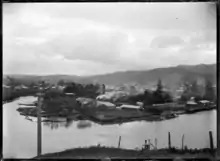
Fire bricks made from fire clay deposits near the Kamo mines supported a brickworks over several decades. Good quality limestone was quarried at Hikurangi, Portland and Limestone Island, and initially sold as agricultural lime, and later combined with local coal to produce Portland cement at the settlement of Portland on the south side of the harbour. Local limestone is still used in cement manufacture, but the coal is now imported from the West Coast of the South Island.
Whangārei was the most urbanised area in Northland towards the end of the 19th century, but grew slowly in the 20th century. The district slowly exhausted most of its natural resources but was sustained by agriculture, especially dairying. Shipping was the main transport link until the North Auckland railway line reached the town in 1925, and the road from Auckland was not suitable for travel in poor weather until 1934.[12] These terrestrial travel routes forced a rapid decline in coastal shipping but stimulated Whangārei to become the service centre for Northland. The population was 14,000 in 1945, but grew rapidly in the 1960s, incorporating Kamo and other outlying areas. In 1964, Whangārei was declared a city. Its population the following year was 31,000.[13]
The second half of the twentieth century brought the establishment and expansion of the oil refinery at Marsden Point on Bream Bay, the adjacent development of timber processing and the establishment of Northland Port, which is mainly focused on timber exporting.
Future
Building of the Hundertwasser Art Centre with Wairau Māori Art Gallery commenced in 2018 after the funding target of $20.97 million was raised by a volunteer team in time for a June 2017 deadline.[14][15] A container port could follow, linked by rail to Auckland. The extensive, flat undeveloped land around Northport is a suggested solution to excess population growth in Auckland and the associated lack of industrial land.[16]
Geography

Geographical features
Mount Parihaka is a volcanic dome rising 259 metres (850 ft) to the northeast of the city centre and part of the Whangārei volcanic field. It is about 20 million years old, and aligns with the Harbour Fault, which also aligns with the volcanoes of Parakiore near Kamo, and Hikurangi near the town of the same name.[17] The dome is surrounded by the Parihaka Scenic Reserve. There is road access to the summit of Parihaka and walking tracks through the reserve,[18] and a bridge linking it to Mair Park. The dome is frequently called Mount Parahaki, but the original Māori spelling of Parihaka was confirmed by the government in 2005.[19]
The Hatea River flows south through the city and empties into Whangārei Harbour. The river has a spectacular 26-metre (85 ft) waterfall in Tikipunga, 6 kilometres (3.7 mi) north of the city.[20]
Matakohe, or Limestone Island, lies in the harbour close to the city. Owned by Whangārei District, it is subject to ecological island restoration by the Friends of Matakohe/Limestone Island Society.
Suburbs
Whangārei Central is the main business district. The city's urban area spreads through the valleys of the surrounding area. The suburbs are:
- Northern: Te Kamo, Springs Flat, Tikipunga, Three Mile Bush, Otangarei, Mairtown, Regent, Kensington and Whau Valley
- Southern/Western: Morningside, Raumanga, Maunu, Horahora, Woodhill, and The Avenues
- Eastern: Riverside, Port Whangārei, Sherwood Rise, Onerahi, and Parahaki.[21]
Climate
Whangārei has an oceanic climate (Köppen Cfb). The climate in this area has mild differences between highs and lows. Summer days occasionally exceed 30 °C, and there is plentiful rainfall spread relatively evenly throughout the year.[22] Using the Trewartha classification Whangārei is firmly a maritime subtropical climate due to its absence of winter cold.
| Climate data for Whangarei (1981–2010) | |||||||||||||
|---|---|---|---|---|---|---|---|---|---|---|---|---|---|
| Month | Jan | Feb | Mar | Apr | May | Jun | Jul | Aug | Sep | Oct | Nov | Dec | Year |
| Average high °C (°F) | 24.3 (75.7) |
24.3 (75.7) |
22.9 (73.2) |
20.5 (68.9) |
18.1 (64.6) |
16.1 (61.0) |
15.3 (59.5) |
15.7 (60.3) |
17.3 (63.1) |
18.7 (65.7) |
20.6 (69.1) |
22.8 (73.0) |
19.7 (67.5) |
| Daily mean °C (°F) | 19.9 (67.8) |
20.2 (68.4) |
18.8 (65.8) |
16.6 (61.9) |
14.4 (57.9) |
12.4 (54.3) |
11.6 (52.9) |
11.9 (53.4) |
13.3 (55.9) |
14.6 (58.3) |
16.4 (61.5) |
18.5 (65.3) |
15.7 (60.3) |
| Average low °C (°F) | 15.5 (59.9) |
16.1 (61.0) |
14.7 (58.5) |
12.8 (55.0) |
10.8 (51.4) |
8.7 (47.7) |
7.8 (46.0) |
8.2 (46.8) |
9.3 (48.7) |
10.7 (51.3) |
12.3 (54.1) |
14.2 (57.6) |
11.8 (53.2) |
| Average precipitation mm (inches) | 81.2 (3.20) |
95.2 (3.75) |
118.1 (4.65) |
98.9 (3.89) |
111.2 (4.38) |
131.5 (5.18) |
168.6 (6.64) |
128.4 (5.06) |
112.2 (4.42) |
85.3 (3.36) |
77.1 (3.04) |
96.4 (3.80) |
1,304 (51.34) |
| Average precipitation days (≥ 1.0 mm) | 7.9 | 7.9 | 9.3 | 9.8 | 12.5 | 13.9 | 14.8 | 14.8 | 12.6 | 10.5 | 9.4 | 8.7 | 132.1 |
| Average relative humidity (%) | 80.4 | 83.5 | 84.2 | 86.0 | 88.0 | 89.5 | 88.9 | 86.1 | 81.2 | 79.8 | 77.2 | 78.0 | 83.6 |
| Source: NIWA Climate Data[23] | |||||||||||||
Government
National
Whangārei is within the Whangārei electorate and the Te Tai Tokerau Māori electorate. The current MP of the Whangārei electorate is Emily Henderson of the Labour Party. The current MP of the Te Tai Tokerau electorate is Kelvin Davis of the Labour Party.
Local
At a local level, Whangārei comes under the Northland Regional Council, of which the city is the seat.
Whangārei is governed locally by the Whangārei District Council. The city is split into two of the council wards, Denby, which takes the northern suburbs, and Okara, which takes the southern half of the city.
Whangārei is covered by the Northland Police District, which is split into two areas, Whangārei/Kaipara and Mid/Far North.
Judicially, the town is served by the Whangārei District Court and is also the base of the region's only High Court.
Transport
State Highway 1 from Auckland to Cape Reinga passes through Whangārei. State Highway 14 from Dargaville connects to State Highway 1 in Whangārei.
Whangārei Airport is located 7.4 kilometres (4.6 mi) southeast of the city centre, in the suburb of Onerahi.
In July 2013, a second road crossing of the Hatea River was opened, in the form of a bascule bridge.
There are several cycle/walk ways under development connecting the city centre with the outer suburbs. These include Kamo (currently under construction), Onerahi (completed) and Raumanga/Maunu (several sections completed). The Hatea Loop (Huarahi o te Whai) is a central mixed space walkway connecting the Town Basin, Hihiaua Peninsula, Okara, Pohe Island and Riverside areas of the central city.
Whangārei is served by Northport, a seaport at Marsden Point. It was previously served by Port Whangārei, in the upper harbour near the city, which was operated by the Northland Harbour Board until 1988, when it was transferred to the Northland Port Corporation. The first two berths at Marsden Point opened in 2002, and Port Whangārei closed to commercial shipping in 2007 when the remaining cargo operations were transferred to Marsden Point.[24]
Bus
Northland Regional Council organises the CityLink bus service. This bus service runs eight urban bus routes,[25] with bicycle racks from 1 October 2018.[26] On 20 November 2019, Whangārei became the first city to use Bee Cards.[27] 2% of arrivals and 3% of departures in the Whangārei Central census area were by public bus in 2018. In other neighbouring census areas, even fewer used buses.[28]
Intercity operates 3 buses a day from Whangārei, taking about 3 hours[29] for the 158 km (98 mi)[30] to Auckland and 1hr 45 mins to Kerikeri.[29]
Railway
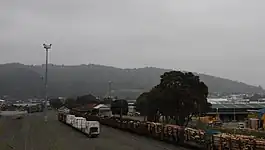
Whangārei is connected to Auckland and Otiria by the North Auckland line, which carries freight only,[31] the container transfer depot being at 33 Porowini Ave.[32]
Station
.jpg.webp)
The railway station lost its last scheduled passenger service on 15 September 1975,[33] although a "with-car" (goods train with a carriage attached) service lasted until June 1976.[34]
Restoration of the station by its Men's Shed occupant began in 2014[35] and was largely complete by 2020.[36] Its Type C design[37] was protected by a NZHPT Category II listing on 24 March 2006 (List Number 7646). The station was opened by the Minister for Railways, Gordon Coates, on 11 March 1925.[38] Predecessor stations had been opened in 1880 and 1903.[37] The 1880 station was about 500 m (1,600 ft) to the north, near Walton Street.[39]
In 1929, the fastest train took 6 hrs 14 mins from Whangārei to Auckland.[40] From 1956, railcars reduced the journey to 4hrs 10 mins.[41] In 1943, the distance was measured as 129 mi 31 ch (208.2 km).[42]
Arts and culture
The Whangārei Art Museum is located in the Town Basin. Artisan markets are held at the nearby Canopy Bridge.
The Hundertwasser Art Centre was built on the site of the former Northland Harbour Board building.
The Quarry Arts Centre is located on the edge of the Western Hills in the Avenues.
The Hātea Loop walkway is an accessible, circular walkway which connects Town Basin, William Fraser Memorial Park,Te Matau a Pohe, Canopy Bridge, Clapham's Clocks and Reyburn House gallery. The walkway offers marina views and various family friendly outdoor activities.
The Whangārei Theatre Company (formerly WOADS) has been staging theatre productions in Whangārei since 1946.[43] They have currently made their home at the Riverbank Centre in the town basin.[44]
Disruptive Performers (Theatre Group) was formed in 2019, and they staged their first production in November 2020.[45]
Whangārei is home to many music organisations, such as Whangārei Youth Music,[46] the Northland Sinfonia, and Sistema Whangārei.
Education
Tertiary education
NorthTec, with its main campus located in the Whangārei suburb of Raumanga, is the chief provider of tertiary education in the Northland Region. It offers degrees, diplomas and certificates in a wide variety of academic, professional and technical fields. The degrees are nationally monitored for quality and so can lead to postgraduate study at universities and other institutions. NorthTec has around 23,000 students studying either part-time or full-time.
The University of Auckland maintains a campus in the city centre. There are also a number of private tertiary educational organisations that provide technical and vocational training.
Schools
There are several schools which offer secondary schooling education within the urban area. Most suburbs have their own primary school.

Secondary schools
- Whangārei Boys' High School, a boys' secondary school with a roll of 1345[47] (April 2023).
- Whangārei Girls' High School, a girls' secondary school with a roll of 1542[47] (April 2023).
- These two secondary schools have a decile rating of 5 and cover years 9–13.[48][49] Both schools opened in 1881.[50][51]
- Kamo High School, which accommodates years 9–13.
- Tikipunga High School, which caters for years 7–13.
- Both of these are co-educational secondary schools serving the northern suburbs.
- Huanui College, a private secondary school just out of the urban area in Glenbervie.
- Te Kura Kaupapa Māori o Te Rāwhitiroa. A Māori language immersion school catering for primary and secondary students.
Intermediate and primary schools
There are two intermediate schools (years 7–8) in the urban area. Several primary schools offer education from years 1–8.
- Whangārei Intermediate is an intermediate (years 7–8) school with a roll of 639.[52]
- Kamo Intermediate is a popular intermediate school serving the northern suburbs.
Primary schools in the urban area include Hurupaki School, Kamo Primary School, Totara Grove School (formerly Kamo East School), Tikipunga Primary School, Otangarei School, Whau Valley School, Whangārei School, a contributing primary (years 1–6) school with a roll of 577,[53] Maunu School, Horahora School, Morningside School, Manaia View School (formerly Raumanga Primary and Raumanga Middle schools, amalgamated), Raurimu Avenue School, and Onerahi School.
Religious and state-integrated schools
Pompallier Catholic College (opened in 1971) is a Catholic state integrated co-educational secondary school (years 7 to 13) with a roll of 560 and a decile ranking of 7, located in the suburb of Maunu. It is the only Catholic secondary school in Northland serving the wider district.
Saint Francis Xavier Catholic School, the city's Catholic primary school, located in the suburb of Whau Valley adjacent to the Catholic Parish.
Christian Renewal School is a composite state integrated co-educational secondary and primary (years 1–13) school with a roll of 201. Around 110 of those students are in high school (years 9–13), as of June 2018.[54] The school was established in 1993 and integrated into the state system in 1997.[55] The secondary half of the school is situated upstairs, and the primary downstairs. The school operates in the Christian Renewal buildings, beside the Renew Church work buildings and auditorium.[56]
Excellere College, a Christian school (years 1–13) located in the northern suburb of Springs Flat. One half of the school is secondary, and the other half is primary. There are 205 students at this school.[57]
The Whangārei Adventist Christian School, located at Whau Valley Road, has been operating for some 50 years and is the second oldest of the independent Christian schools in Whangārei as well. It was formerly called the Whangārei Seventhday Adventist School. Over 30 students attend the school, as of June 2018.[58]
Infrastructure and services
Healthcare
Whangārei is within the Northland District Health Board. The single primary health care organisation (PHO), Te Kaupapa Mahitahi Hauora Papa O Te Raki Trust, commonly known as Mahitahi Hauora, was created in 2019 through a process of coming together with the previous Northland PHOs.[62] Whangārei Hospital (formerly Northland Base Hospital) is Northland DHB's largest and provides secondary specialist care to all of Northland. It has 246 inpatient beds, and is based in the suburb of Horahora.
Mercy Hospital was established in 1963 by the Sisters of Mercy.[63]
Kensington Hospital, opened in March 2001, is a private healthcare facility.
Utilities
Northpower owns and operates the local electricity distribution network servicing the city, with electricity supplied from Transpower's national grid at the Maungatapere substation southwest of the city. There is very little generation in Northland and Auckland, so most of the city's electricity is transmitted from the Waikato.
Natural gas arrived in Whangārei in 1983, with the completion of the high-pressure pipeline north from Auckland to the city, now operated by First Gas.[64] First Gas also operates the gas distribution network within the city.
Sports
Whangārei is home to the Northland rugby union team, a professional side competing in the Bunnings NPC, the highest level of provincial rugby in New Zealand. They play out of Okara Park (currently known as "Toll Stadium" due to a sponsorship agreement), the largest stadium in the region, which also hosted two matches during Rugby World Cup 2011. The city also hosted a match on 3 June between a Provincial XV team (NZ Provincial Barbarians) and the British and Irish Lions during their 2017 tour.
Cobham Oval has hosted Black Caps one-day international cricket matches, with the first taking place in 2012.[65]
The football (soccer) club North Force who compete in the Lotto Sport Italia NRFL Division 1 are based in Whangārei.
Whangārei has a Field Hockey facility that hosted several international matches. Several hockey players from Northland have been selected for the Black Sticks Women since 2000.
Whangārei is home to the northernmost parkrun in New Zealand. This is a free, weekly, timed 5 km (3 mile), held every Saturday at 8am. The start and finish is under Te Matau o Pohe bridge.[66]
The International Rally of Whangārei is based in the region with competitors from Australia, India, China, Japan, South East Asia and Pacific Islands racing on dirt roads in the districts surrounding Whangārei. It is the season opening event for both the Asia-Pacific Rally Championship and the New Zealand Rally Championship and is New Zealand's second-largest international motorsport competition, second only to the world championship event, Rally New Zealand. Whangārei Speedway attracts drivers from outside the Northland region.
Northland is also represented at the highest national domestic level in golf.
The Northland rugby league team, representing the Northland Region in New Zealand Rugby League competitions, is based in Whangārei. They currently compete in the Albert Baskerville Trophy as the Northern Swords. Between 2006 and 2007 they were part of the Bartercard Cup, playing under the name the Northern Storm. Northland was originally known as North Auckland and has previously used the nickname the Wild Boars.
See also
References
Citations
- Taonui, Rāwiri. "Naming Whāngārei Harbour". teara.govt.nz. New Zealand Ministry for Culture and Heritage Te Manatu. Retrieved 10 January 2021.
- "Subnational population estimates (RC, SA2), by age and sex, at 30 June 1996-2023 (2023 boundaries)". Statistics New Zealand. Retrieved 25 October 2023. (regional councils); "Subnational population estimates (TA, SA2), by age and sex, at 30 June 1996-2023 (2023 boundaries)". Statistics New Zealand. Retrieved 25 October 2023. (territorial authorities); "Subnational population estimates (urban rural), by age and sex, at 30 June 1996-2023 (2023 boundaries)". Statistics New Zealand. Retrieved 25 October 2023. (urban areas)
- Taonui, Rāwiri (8 February 2005). "Naming Whangārei Harbour". Te Ara: The Encyclopedia of New Zealand. Ministry for Culture and Heritage. Retrieved 1 September 2022.
- Cameron, Ewen; Hayward, Bruce; Murdoch, Graeme (2008). A Field Guide to Auckland: Exploring the Region's Natural and Historical Heritage. Random House New Zealand. p. 109. ISBN 978-1-86962-1513.
- Taonui, Rāwiri (8 February 2005). "Ancestors". Te Ara: The Encyclopedia of New Zealand. Ministry for Culture and Heritage. Retrieved 1 September 2022.
- Hooker, Brian (September 1997). "Portages of early Auckland – to and from the Waitemata Harbour: The hub of an ancient communications network". Auckland-Waikato Historical Journal (70): 39–40. Retrieved 21 July 2022.
- Taonui, Rāwiri (8 February 2005). "Tribes of Whangārei". Te Ara: The Encyclopedia of New Zealand. Ministry for Culture and Heritage. Retrieved 1 September 2022.
- A. H. Reed (1968). Historic Northland.
- Pickmere, Nancy Preece (1986). Whangarei: The Founding Years. pp. 1–6.
- Pickmere, pp 20–46
- Pickmere, pp 87–88
- "Whangarei City and environs". Te Ara: The Encyclopedia of New Zealand. Archived from the original on 16 February 2008.
- "Whangarei". Bateman New Zealand Encyclopedia (4th ed.). 1995. p. 632.
- "Unfinished Hundertwasser art project revived in NZ". euronews.com. 19 June 2017. Archived from the original on 12 November 2017. Retrieved 30 April 2018.
- Lambly, Annette (19 June 2018). "Work on Whangarei $26m Hundertwasser Art Centre gets underway". Stuff.
- "Marsden Point – The Hype and The Reality". TelferYoung (Northland) Limited. June 2006. Archived from the original on 25 July 2008.
- Hayward, Bruce; Isaac, Mike; Miller, Keith; Spörli, Bernhard (2002). "Introduction to Whangarei geology" (PDF). Geological Society of New Zealand. p. 27. Archived from the original (PDF) on 4 March 2009.
- Parkes, W. F. (1992). Guide to Whangarei City and District. p. 7. ISBN 0-473-01639-7.
- "Mount Parihaka name corrected". 19 July 2005. Archived from the original on 20 January 2009. Retrieved 14 August 2008.
- Parkes, p 11
- "Parahaki Whangarei". Google Maps. Retrieved 25 August 2020.
- "Whangarei, New Zealand Köppen Climate Classification (Weatherbase)". Weatherbase. Archived from the original on 4 March 2016. Retrieved 30 April 2018.
- "Climate Data and Activities". NIWA Science. 28 February 2007. Archived from the original on 10 October 2013. Retrieved 15 October 2013.
- Liang, Annejo (2010). Ports of Whangarei (PDF). Whangarei District Council. Archived from the original (PDF) on 21 April 2017. Retrieved 30 October 2017.
- "CityLink – Whāngārei Bus Service, Routes, Stops". CityLink Whangarei. Retrieved 2 May 2021.
- "Bus your Bike – CityLink Whangarei". CityLink Whangarei. Retrieved 24 September 2018.
- "Bee Card is here!". Northland Regional Council. Retrieved 12 January 2020.
- "Waka Commuter". commuter.waka.app. Retrieved 2 May 2021.
- "Book Bus Tickets Online". www.intercity.co.nz. Retrieved 2 May 2021.
- "Sky Tower to 91 Dent St (The Hub, Town Basin)". Google maps. Retrieved 3 May 2021.
- "Northland rail rejuvenation". KiwiRail. Retrieved 2 May 2021.
- "Whangarei". KiwiRail. Retrieved 2 May 2021.
- Scoble, Juliet (2010). "Names & Opening & Closing Dates of Railway Stations" (PDF). Rail Heritage Trust of New Zealand.
- Brett & van der Weerden 2021, p. 207.
- "City's old railway station getting back on track". NZ Herald. 20 May 2014. Retrieved 2 May 2021.
- "Railway Rd". Google Maps. Retrieved 2 May 2021.
- "Whangarei Station". railheritage.org.nz. Retrieved 2 May 2021.
- "Whangarei Railway Station". www.heritage.org.nz. Retrieved 2 May 2021.
- "Town of Whangarei". National Library of New Zealand. 1886. Retrieved 3 May 2021.
- "AUCKLAND STAR". paperspast.natlib.govt.nz. 25 March 1929. Retrieved 3 May 2021.
- T. A. McGavin (Spring 1967). "Railcars No More to Whangarei, Tauranga or Westport". New Zealand Railway Observer. New Zealand Railway and Locomotive Society. 24 no. 3 (113): 88. ISSN 0028-8624.
- "Station Archive". Rail Heritage Trust of New Zealand. 2012.
- "Sixty years of Whangarei Theatre Company". The Northern Advocate. 17 November 2006.
- "About". Whangarei Theatre Company. Retrieved 15 December 2020.
- Bryant, Jodi (17 November 2020). "Humpty Dumpty's terrible fate debuts in Whangārei play about bullying". The Northern Advocate.
- "Homepage". Whangārei Youth Music. Retrieved 22 November 2021.
- "New Zealand Schools Directory". New Zealand Ministry of Education. Retrieved 12 December 2022.
- Education Counts: Whangarei Boys High School
- Education Counts: Whangarei Girls High School
- "Whangarei Boys' High School -Our History". Whangarei Boys' High School. Archived from the original on 14 October 2008.
- "Whangarei Girls' High". Whangarei Girls' High School. Archived from the original on 29 June 2007.
- "Te Kete Ipurangi – Whangarei Intermediate". Ministry of Education. Archived from the original on 11 July 2009. Retrieved 16 March 2008.
- "Te Kete Ipurangi – Whangarei School". Ministry of Education.
- "Te Kete Ipurangi – Christian Renewal School". Ministry of Education.
- Counts, Education. "Ministry of Education – Education Counts". www.educationcounts.govt.nz. Retrieved 16 January 2019.
- "Supplementary Review Report: Christian Renewal School". Education Review Office. May 2005.
- Counts, Education. "Ministry of Education – Education Counts". www.educationcounts.govt.nz. Retrieved 16 January 2019.
- Counts, Education. "Ministry of Education – Education Counts". www.educationcounts.govt.nz. Retrieved 16 January 2019.
- "Education Review Report: Blomfield Special School and Resource Centre". Education Review Office. December 2007.
- "Te Kete Ipurangi – Blomfield Special School & Resource Centre". Ministry of Education.
- "Blomfield Special School – locations". Blomfield Special School. Archived from the original on 14 October 2008.
- "Providing support for primary health care across Northland – Mahitahi Hauora". www.mahitahihauora.co.nz.
- "Our Heritage". Mercy Hospital.
- "The New Zealand Gas Story". Gas Industry Company. December 2016. Retrieved 31 October 2018.
- "Cobham Oval". ESPNCricinfo. Retrieved 18 August 2018.
- "Whangarei parkrun – Weekly Free 5km Timed Run". parkrun New Zealand. Retrieved 12 January 2021.
Bibliography
- Brett, André; van der Weerden, Sam (2021). Can't Get There From Here – New Zealand Passenger Rail Since 1920. Otago University Press. ISBN 9781990048098.



